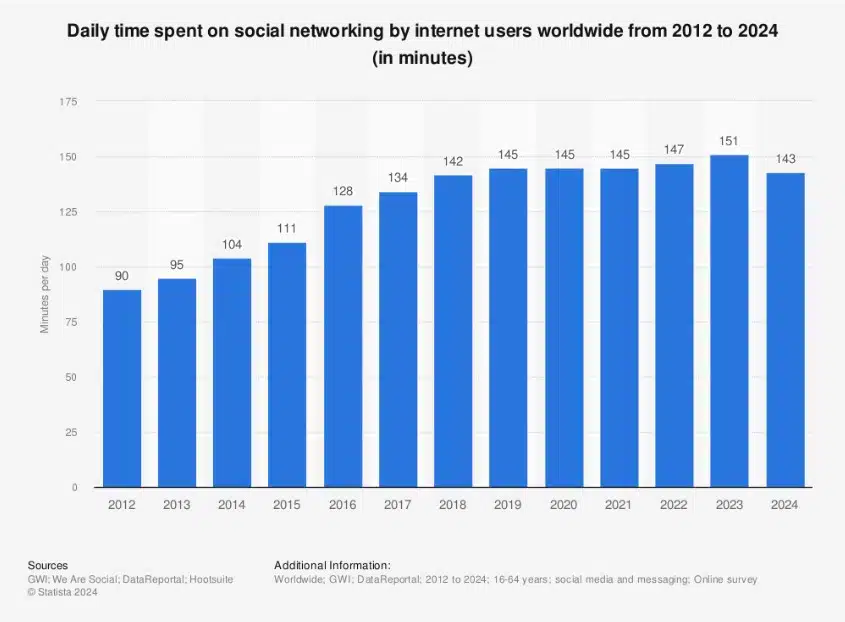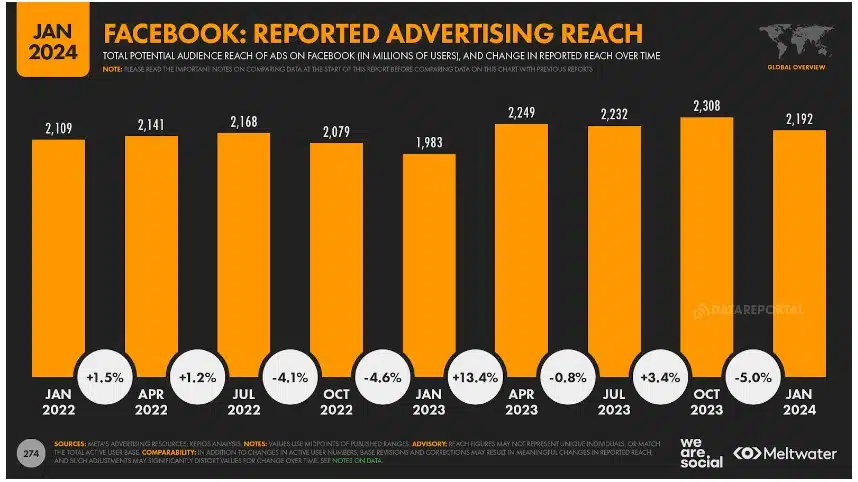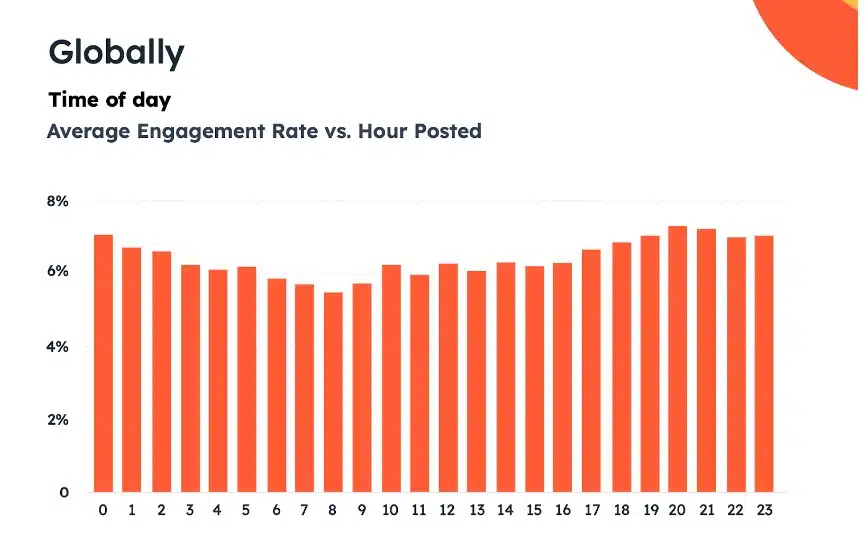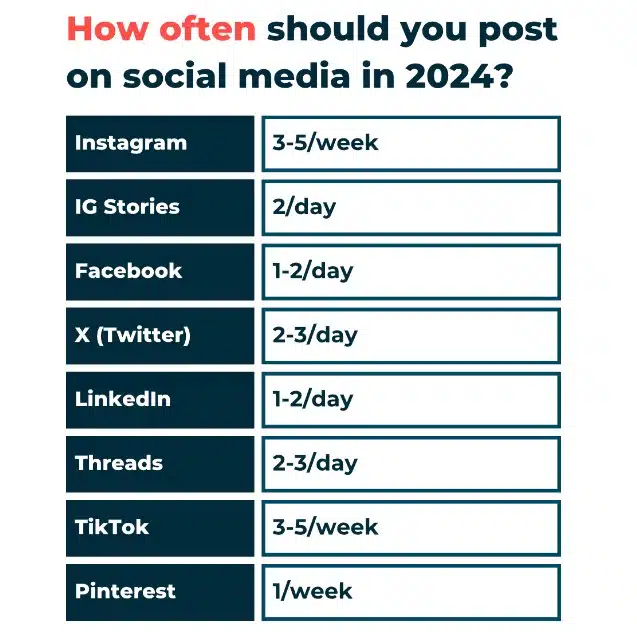In 2024, over 5 billion people were using social media platforms. Statista projects that there will be over 6 billion social media users by 2028. As the number of users rises, so does your potential audience.
At the same time, as social media usage increases, reach is stagnating. Users are becoming numb to the constant barrage of marketing content finding itself on their feeds. Competition for consumer attention is stiffer than ever before.
With so many variables at play, how can businesses like yours reach new audiences?
In this guide, we’ll explain how to expand your organic reach on social media channels.
Understanding social media reach
Social media reach is the measure of how many different people view your social media content. For example, someone scrolls through their Instagram feed, and your post pops up. That interaction counts towards your reach on social media. However, if the same person sees the same post again, your reach remains the same.
In practical terms, social media reach identifies the size of your audience on each platform. Prioritizing organic reach is one of the best small business growth strategies today.
Inorganic vs organic reach on social media
There are several ways businesses and influencers can reach social media users. Most fall into either organic or inorganic reach.
Organic reach
Organic reach on a social media service provider is when platform users are exposed to your content naturally. For example, someone follows your Facebook account. The next time they log in, they see you post about an upcoming event.
Natural, relevant interactions like this depend on well-designed content. Organic content includes any type of social media post, from images to videos to blog articles. Using banner templates can help streamline the design of promotional content, ensuring it is both visually appealing and aligned with your brand’s message.
Inorganic reach
Inorganic reach is when you pay for social media advertising. Services like Facebook Ads allow you to target users based on behavior and demographics. When users log into their accounts, they are exposed to these sponsored posts. In these cases, the interaction isn’t organic because it only takes place due to ad placement.
This strategic approach to monetize social networking can significantly amplify your visibility and user engagement, turning views into revenue.
Knowing your social media reach isn’t equivalent to knowing important factors, such as how to calculate total addressable market for your business. The former is unknown and untapped while the latter is hard-capped by the maximum demand for your products.
Viral reach
Viral reach is a different type of measurement on social media. The concept refers to how many people see your content because other users share or engage with it. Viral reach can be a result of either organic or inorganic reach. The viral reach metric can be a good indicator of whether or not you’re sharing compelling, engaging content.
Benefits of organic reach on social media
The average global internet user spends two hours and twenty-three minutes on social media per day. You have ample opportunity to connect organically with your target audience.

Image sourced from statista.com
Increasing your social media reach takes research, planning, and plenty of resources. Of course, it’s the many benefits of growing your social channel reach that make it all worth it, including:
- Connecting with your target audience: create authentic bonds with your followers on their preferred channels.
- Reaching more potential customers: connect with social media users that you wouldn’t find otherwise.
- Increasing brand awareness: a stronger brand presence means more people recognize and talk about your brand.
- Gaining new insights: monitor post engagement and user feedback to gain a new understanding of your audience.
- Boosting traffic and engagement: organic content reaches new users, increasing views and engagement.
- Improving SEO: better-performing social media profiles rank higher in search engine rankings.
- Raising conversion rates: a broader reach helps you generate leads and increase conversions.
- Achieving better ROI: build natural connections with your audience without spending on ads.
12 best practices for increasing your organic reach on social media platforms
Before diving into the general practices that apply to all, it’s crucial for those in B2B markets to tailor their social media marketing strategy to effectively increase their organic reach, aligning with the unique dynamics of business-to-business engagement. This tailored approach ensures that the following best practices can be adapted to meet the specific needs of B2B audiences.
Alright, so you’re convinced of the importance of social media reach. It’s time to start posting tons of content and you’ll be on your way, right? Well, the data says otherwise.
A recent report from Social Insider has found an 18% year-on-year decline in the average reach for Instagram. Likewise, Datareportal discovered that Facebook Ad reach was down 5.0% in 2024.

Image sourced from datareportal.com
Don’t get bogged down in negative news and trends, though. There’s plenty of the pie left over for businesses who know how to expand their social media reach. Follow these best practices to increase your reach on social media networks.
1) Craft compelling and original content
It may be obvious that you need to put out interesting content to reach and connect with your target audience segments. With social media, many fall into the temptation to post frequently without putting a lot of thought into what to post.
Platforms like X may limit your characters to 280. Don’t let such limitations stop you from smart storytelling. Even on other platforms, it’s best to keep posts concise. Create a blend of witty, entertaining, informational, and marketing content. Follow the 80/20 rule while keeping the marketing to 20 percent of your social media posts.
2) Know your audience
Don’t be at the mercy of Facebook, Instagram, and other platforms’ news feed algorithms. Give yourself the best chance to reach your audience by understanding exactly who they are. Besides knowing demographics, what are their interests? What do they engage with?
More importantly, what social media platforms are your audience most active on? Do your market research and pay attention to social media user trends. Recent data shows that users aged 18-29 years are most likely to be found on Snapchat. Users aged 30-39 years split their time nearly evenly between LinkedIn, X, Snapchat, and Instagram.

Image sourced from sproutsocial.com
3) Optimize your social profiles
You optimize your website content for SEO. Why not boost your social media profiles with similar tactics? Instead of targeting search engine algorithms, you want to make your account as relevant to your target audience as possible.
Follow these basic tips to optimize your social profile pages for brand recognition and reach:
- Always stay consistent and on-brand
- Choose a catchy username that is memorable
- Upload a recognizable image or logo
- Apply your SEO knowledge to include target keywords in summaries and descriptions
- Always add a trackable link to your main website
Don’t be afraid to update some profile assets to fit with current campaigns or promotions. It’s also beneficial to check out the profile pages of some of your competitors and get inspiration.
4) Go evergreen
Social media is mostly about the here and now. Viral trends change with weather at times and it can be a lot to stay on top of. You should be posting current, relevant content daily on your socials. That’s not the only way to expand your reach organically.
Think evergreen when creating social media content. Text, images, and videos can all be relatively timeless. Talk about common pain points in your industry or popular questions from customers.
For example, if you provide a cloud PBX system for small businesses, post content about the challenges of traditional business phones. Create posts that link to evergreen content on your website such as how-to guides on your blog.
5) Build targeted content
You can grow your reach without having to use paid advertising. How do you do this? By creating targeted social media content. The first step is to identify who you want to reach and tailor your post to their interests and needs.
For instance, if your target audience includes renters, crafting posts that explain the advantages of tenant insurance can resonate well and drive engagement. Conduct market research and gain customer feedback to help you draw up buyer personas.
You can also use the tools available on social media platforms. For example, use Instagram polls to gather follower preferences. Another option is to use a feature like Facebook’s organic post targeting. The feature lets you target users based on profile details such as education, age, and location.
6) Post at the right times
If the best social media post goes live but no one is active to view it, does it really exist? Part of understanding social media marketing is knowing when your audience is online.

Image sourced from blog.hubspot.com
Hubspot research identified the best time of day to post social content to be between 7 to 9 pm. However, different platforms have specific times of peak activity. LinkedIn might be busier during normal work hours while TikTok and Snapchat take off after dinner.
The geographic location of your target audience also affects when users are most active on social media channels.
Think of social media posting like a business profitability analysis. Instead of finding what products have the best return, you want to find what times have the best results.
7) Promote your social media accounts
A great way to expand your reach is promotion. No, we’re not talking about discounts. We mean you should be promoting your social media accounts on all of your other channels including—wait for it, your social media channels!
The first place to start is with your website. Use WordPress plugins or widgets to add link buttons for all of your social accounts to your homepage. Even better, add the buttons to a sidebar, footer, or header so that users can quickly access your feeds at any time. Adjusting the WordPress page order can help place these links where they’ll get the most visibility.
You can also use social media aggregator tools to feature some of your posts in real time to engage website visitors.
To facilitate even quicker access, consider enabling users to scan QR on Android or other devices, leading them directly to your social profiles or specific promotions.
Another avenue is to look at non-social channels such as news sites and blogs. Use solutions like AgilityPR to monitor your media mentions and pop up with links to your website and socials when appropriate.
8) Always respond and engage
One of the best ways to grow your social media presence is to engage with audience interactions. If someone comments on a post, respond. If someone gives you a mention, be sure to give it a like or answer any questions or concerns.
Do you know an easy way to stay engaged with your audience on multiple platforms and promote customer success? Use social listening tools like Hootsuite. Listening solutions make it easy to track user engagement and reply to every comment.
If you have a lot of followers, it can be difficult to always respond to each comment. Leverage conversational AI solutions to engage with social media users and enhance customer support.
9) Cross-post relevant content
Cross-posting content is an efficient way to engage users on multiple platforms. What is cross-posting? It’s when you take a post from one social media channel and share it on a different one.
Now, it’s more nuanced than copying and pasting content. Follow the basics of effective social cross-posting:
- Always tailor the content to the platform and target audience expectations.
- Post similar content at different times to avoid spamming users
- Optimize content like images and video to meet platform specs.
- Don’t cross-post everything
10) Leverage hashtags and users
Hashtags are like free shots at reaching new social media users. Use social media analytics tools to gain insight into what hashtags are getting the most engagement. Also, take a peek at your competitors to see what they’re doing.
You can do more, though, by creating branded and promotional hashtags. Bespoke tags enable you to focus on marketing campaigns and promote user-generated content (UGC).
A great way to reach your audience is to get help from the user base. User-generated content is organic, shareable, and ready to go viral. Create social media posts that encourage followers to engage and share your content with their followers.

Image sourced from instagram.com
One successful example of hashtags and UGC is the Starbucks White Cup Contest. Users were asked to decorate Starbucks cups and include #WhiteCupContest so others could easily find the content.
11) Don’t overdo it
It may appear at first that if you post more often, then you’ll get more views and higher engagement. Posting on social media, however, takes a Goldilocks approach. Not too much and not too little, but “just right.”
Research from Hootsuite found the following ideal social media post frequency for popular platforms:

Image sourced from blog.hootsuite.com
12) Measure key social media metrics
How can you expand your reach on social media if you’re not monitoring your performance? Use social media analytics tools like Buffer and SproutSocial to measure and track your content. You can also use built-in analytics such as Instagram Insights or the best contact center solutions to track reach.
Here are some key social media metrics to monitor:
- Reach
- Impressions
- Engagement
- Click-through rate (CTR)
- Shares and retweets
- Audience growth
- Hashtag performance
Track these metrics and more, to better understand how to reach and engage with your audience. Identify what’s working and what isn’t and adjust your social media strategy accordingly.
Expand your organic reach on social media
People will continue to flock to social media networks. While user feeds will become increasingly crowded, focus on creating content that appeals to your target audience. Let others worry about paid, inorganic tactics.
Plan and create engaging social media content. Interact with your audience’s preferred channels. Optimize your account profiles and follow the other tips in this guide. Before you know it, you’ll be gaining new likes and followers as your audience numbers grow.



